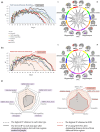Behavioral dishonesty in multiscenes: Associations with trait honesty and neural patterns during (dis)honesty video-watching
- PMID: 38853713
- PMCID: PMC11163231
- DOI: 10.1002/hbm.26710
Behavioral dishonesty in multiscenes: Associations with trait honesty and neural patterns during (dis)honesty video-watching
Abstract
Cross-situational inconsistency is common in the expression of honesty traits; yet, there is insufficient emphasis on behavioral dishonesty across multiple contexts. The current study aimed to investigate behavioral dishonesty in various contexts and reveal the associations between trait honesty, behavioral dishonesty, and neural patterns of observing others behave honestly or dishonestly in videos (abbr.: (dis)honesty video-watching). First, the results revealed limitations in using trait honesty to reflect variations in dishonest behaviors and predict behavioral dishonesty. The finding highlights the importance of considering neural patterns in understanding and predicting dishonest behaviors. Second, by comparing the predictive performance of seven types of data across three neural networks, the results showed that functional connectivity in the hypothesis-driven network during (dis)honesty video-watching provided the highest predictive power in predicting multitask behavioral dishonesty. Last, by applying the feature elimination method, the midline self-referential regions (medial prefrontal cortex, posterior cingulate cortex, and anterior cingulate cortex), anterior insula, and striatum were identified as the most informative brain regions in predicting behavioral dishonesty. In summary, the study offered insights into individual differences in deception and the intricate connections among trait honesty, behavioral dishonesty, and neural patterns during (dis)honesty video-watching.
Keywords: anterior insula; behavioral dishonesty; medial prefrontal cortex; striatum; trait honesty.
© 2024 The Author(s). Human Brain Mapping published by Wiley Periodicals LLC.
Conflict of interest statement
We have no known conflict of interest to disclose.
Figures




Similar articles
-
Individual differences in (dis)honesty are represented in the brain's functional connectivity at rest.Neuroimage. 2022 Feb 1;246:118761. doi: 10.1016/j.neuroimage.2021.118761. Epub 2021 Nov 30. Neuroimage. 2022. PMID: 34861396
-
Functional connectivity between the caudate and medial prefrontal cortex reflects individual honesty variations in adults and children.Neuroimage. 2021 Sep;238:118268. doi: 10.1016/j.neuroimage.2021.118268. Epub 2021 Jun 14. Neuroimage. 2021. PMID: 34139359
-
Neural mechanisms of deliberate dishonesty: Dissociating deliberation from other control processes during dishonest behaviors.Proc Natl Acad Sci U S A. 2021 Oct 26;118(43):e2109208118. doi: 10.1073/pnas.2109208118. Proc Natl Acad Sci U S A. 2021. PMID: 34663732 Free PMC article.
-
Intuitive Honesty Versus Dishonesty: Meta-Analytic Evidence.Perspect Psychol Sci. 2019 Sep;14(5):778-796. doi: 10.1177/1745691619851778. Epub 2019 Jul 10. Perspect Psychol Sci. 2019. PMID: 31291557
-
Cognitive control and dishonesty.Trends Cogn Sci. 2022 Sep;26(9):796-808. doi: 10.1016/j.tics.2022.06.005. Epub 2022 Jul 13. Trends Cogn Sci. 2022. PMID: 35840475 Review.
Cited by
-
Predicting honest behavior based on Eysenck personality traits and gender: an explainable machine learning study using SHAP analysis.Front Psychol. 2025 Apr 9;16:1525606. doi: 10.3389/fpsyg.2025.1525606. eCollection 2025. Front Psychol. 2025. PMID: 40271375 Free PMC article.
-
Neural dynamics of deception: insights from fMRI studies of brain states.Cogn Neurodyn. 2025 Dec;19(1):42. doi: 10.1007/s11571-025-10222-4. Epub 2025 Feb 20. Cogn Neurodyn. 2025. PMID: 39991015
References
-
- Allport, G. W. (1937). Personality: A psychological interpretation. American Psychological Association.
-
- Archambeault, D. S. , Webber, S. , & Greenlee, J. (2015). Fraud and corruption in U.S. nonprofit entities:A summary of press reports 2008–2011. Nonprofit and Voluntary Sector Quarterly, 44(6), 1194–1224.
-
- Ashton, M. C. , & Lee, K. (2009). The HEXACO–60: A short measure of the major dimensions of personality. Journal of Personality Assessment, 91(4), 340–345. - PubMed
-
- Ashton, M. C. , Lee, K. , & de Vries, R. E. (2014). The HEXACO honesty‐humility, agreeableness, and emotionality factors. Personality and Social Psychology Review, 18, 139–152. - PubMed
-
- Burger, J. M. (2014). Personality. Cengage Learning.
MeSH terms
Grants and funding
LinkOut - more resources
Full Text Sources
Medical

